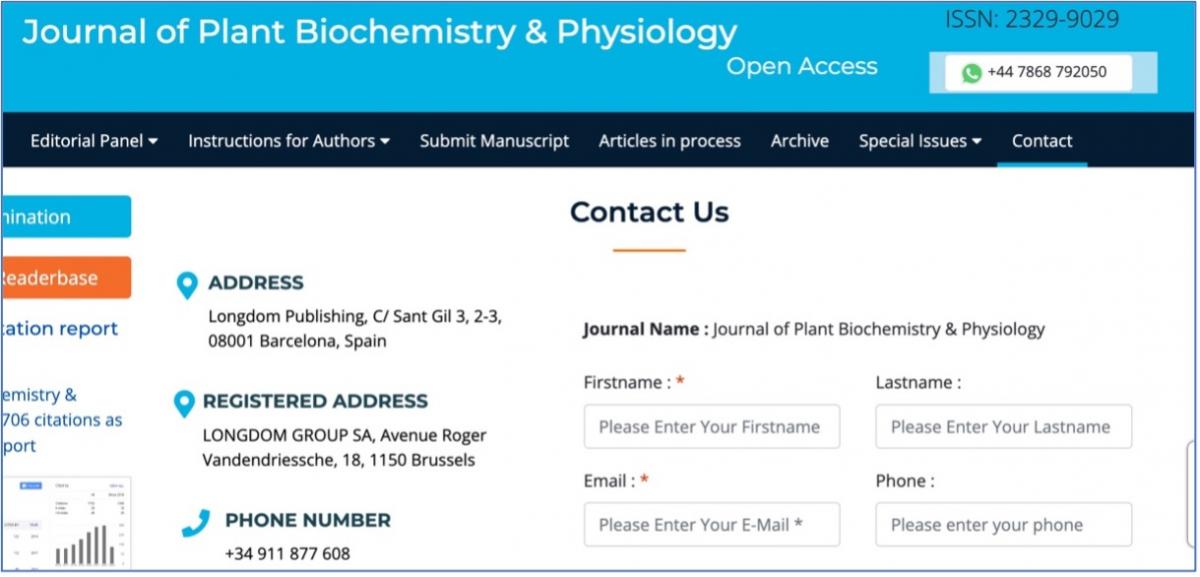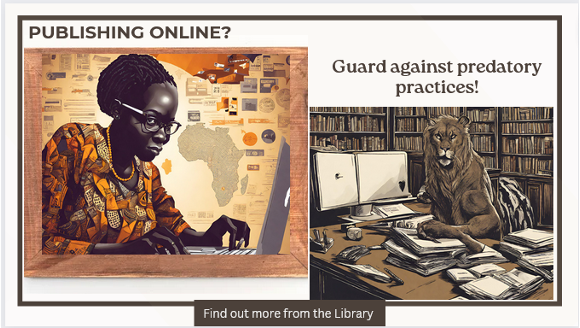The Benefits of Online Publishing and the Need to Guard Against Predatory Practices
Introduction: Why is open access publishing beneficial to academics?
Why might you want to publish your research in an open access journal? Open access journals use Creative Commons licences, which lay out the terms under which they can be used and distributed. All Creative Commons licences require full attribution. Open access can benefit scholars because wider access to their research, enhances visibility and citations.[1]
Figure 1 shows some of the possible benefits of OA publishing, many of which are relevant to researchers around the world, including those in Africa.
Figure 1: Benefits of open access publishing

What are predatory journals?
Most open access journals are highly respected and entirely legitimate. The Directory of Open Access Journals (DOAJ) lists more than 20,000 journals, many without an author processing fee:
Figure 2: DOAJ coverage[2]

The Department of Higher Education and Training (DHET) in South Africa includes the DOAJ journals amongst its list of accredited journals. Academics, researchers, and librarians are sure to find a reliable open access journal on the DOAJ database or any of the others that DHET lists.[3]
Even so, there are scores of journals that can be classified as ‘predatory’; they prey on the unwary who want to publish or to read a reliable article.
What is a predatory journal? In 2019, a group of legal experts and publishers agreed on this definition:
"Predatory journals and publishers are entities that prioritize self-interest at the expense of scholarship and are characterized by false or misleading information, deviation from best editorial and publication practices, a lack of transparency, and/or the use of aggressive and indiscriminate solicitation practices."
Though it might seem straightforward, there are so many forms of predatory practices that this group of specialists had trouble agreeing on a definition to describe how predation manifests itself.[4]
Experts [5] believe that there are now more than 15,000 predatory journals, which promise:
- Peer review with a fast turnaround time.
- Low author processing fees—low in comparison to some of the top tier journals, but high in terms of what authors get for their money.
- Online publication and visibility.
- Indexing in platforms such as Scopus and Web of Science.
Figure 3: How to spot a predatory journal[6]

OER Africa has a free online tutorial on open access publishing, which includes suggestions on how to verify a journal’s legitimacy.[7] There is also a discussion in Open Knowledge Primer for African Universities on the ways in which DOAJ tries to ensure that the journals in its database are legitimate.[8]
All researchers are under pressure to publish to keep their jobs and become eligible for promotion. The pressure on African scholars is increased because they cannot afford the high publication fees some journals charge, and some may not be familiar with the steps necessary to evaluate journals.
Two researchers are quoted in a 2022 article in the Africa Edition of University World News to illustrate the dilemmas facing African scientists who must publish but have neither the funds to pay the APC costs of top-tier journals nor the knowhow to discern the legitimate from the predatory.[9]
One scientist, Euclides Sacomboio of Agostinho Neto University in Angola, had two articles published in disreputable journals. His preference would have been high-impact journals, but, as he told University World News:
"I earn US$500, and the article processing fee in reputable journals is about US$2,180. Where do I get the money without any support?"
Sacomboio added:
"To me, it was important to share my data. Worse, it was difficult to choose [where to publish] because some of these journals we call predatory have peer review processes."
The second scientist, Moses Samje of the University of Bamenda, Cameroon and a member of the African Academy of Sciences Chapter of Affiliates, was also taken in—this time because the journal’s focus was on research like his and because of the journal’s allegedly high impact factor. Samje said:
"The impact factor was quite attractive. It was too good to be true … We had to try and we submitted a paper and, in the space of 24 hours, they [the publishers] asked for the processing charge, which was getting way more affordable. In less than 48 hours, we received an e-mail [saying] our paper was online. I was quite excited."
Samje subsequently went online and discovered that the journal’s peer review process was not as it seemed; he believes that the journal is a sham.
‘Plagiarism, fraud, and predatory publishing’
The noted bioethicist, Arthur Caplan, wrote those words in 2015 and called predatory journals ‘polluting journals.’[10]
Although the points in figure 3 elucidate the major ways to identify a predatory journal, there are two additional strategies they employ. Predatory journals are noted for accepting plagiarized articles and those that have already been published elsewhere. Even though predatory journals may report that they check for plagiarism, they typically don’t.
A 2018 blog post in the Indian newsletter, The Wire, succinctly described the situation in India and gave examples. The authors wrote:[11]
"Fake journals and plagiarism in academics go hand-in-hand. The lack of peer review and a complete absence of quality checking provides a safe channel to publish plagiarised articles. It is therefore no coincidence that along with fake journals, almost all academic fields have also seen an epidemic of plagiarism."
Sometimes plagiarism is intentional; other times it is the result of a researcher’s lack of expertise on what the concept means.
It isn’t always easy to find specific examples of plagiarism. Science Integrity Digest is one source of information. In 2020, it reported on a clear case of plagiarism in which the work of the OstrowskiLab was stolen and published in a predatory journal.[12] In 2019 in the Journal of Nursing Scholarship, authors wrote about numerous instances of plagiarism in three predatory nursing journals.[13]
In South Africa, Professor Nicki Tiffin, a former researcher at the University of Cape Town (UCT) found that not only had she been plagiarized in a predatory journal, but her name had been stolen too.[14]
Unwary researchers are also trapped because some predatory journals have titles very similar to those of reputable journals. The three journals in the figure below all have similar titles but the similarity ends there.
What's in a name?



The first journal, Plant Physiology and Biochemistry is published by Elsevier, a reputable scientific publisher. The second, Journal of Plant Biochemistry and Physiology, is published by Longdom Press. Note it has phone numbers in Great Britain and in Spain and a registered address in Brussels. The journal is not included in any of the major indexing services that have quality controls, such as Web of Science, Scopus, or PubMed. The third, Journal of Plant Biochemistry & Physiology, is published by Omics, a publisher that was sued by the US Federal Trade Commission for predatory practices and ordered to pay a fine of more than $50 million.[15]
How to help researchers distinguish between the fake and the real
Above, we outlined several ways to determine legitimate journals from predatory ones. The two OER Africa publications we cited offer detailed help to students, researchers, and librarians.
Intellectual property rights, plagiarism, and referencing are taught in the Use of Libraries or embedded in the Use of English course, which is an integral part of the compulsory General Studies (GS) for first year students in Nigerian universities. However, the effect of the course on students has been found to be minimal.[16] Traditionally, African academic libraries run library orientation activities for new students. This window of opportunity could be widened to include provision of information packs or tutorials (online and physically) on information literacy, copyright, and plagiarism issues (including an introduction to plagiarism detecting software), as well as information about predatory journals.
Figure 4: AfLIA poster for use in libraries

Academic libraries can play an important role in raising awareness to the need to be wary of predatory practices. But universities as a whole should be engaged in preventing staff and students from falling prey to these journals. They can list the open access journals for which academics associated with their institution can use for purposes of promotion, tenure, and contracts. The DHET site discussed above would be a good place start. Supervisors can advise their PhD students about conducting a literature review without including predatory journals. Sarah Elaine Eaton of the University of Calgary wrote the following about the need of universities to support their students and academics against predation: [17]
"There are implications for mentors of graduate students and early-career stage academics, as well as for institutions as a whole. The issue of questionable conferences and publications is so complex that early-stage academics require support and mentorship to cultivate a deeper understanding of how to share their work in a credible way."
Dr. Eaton’s statement is valid around the world, particularly in circumstances such as Drs. Sacomboio and Samje described—insufficient funds to pay fees and insufficient guidance within the institution.
[1] See Sharing Africa’s knowledge through openly licensed publishing for more information on open access. https://www.oerafrica.org/content/sharing-africa’s-knowledge-through-openly-licensed-publishing
[3]See https://www.up.ac.za/news/post_3048195-the-department-of-higher-education-and-training-2022-accredited-journals-
[4]Grudniewicz, A., Moher, D., Cobey, K.D. et al. (2019). Predatory journals: no definition, no defence. Nature, Vol. 576: 210-212. Retrieved from https://media.nature.com/original/magazine-assets/d41586-019-03759-y/d41586-019-03759-y.pdf
[5]The Interacademy Partnership. (2022). Combatting Predatory Academic Journals and Conferences. Retrieved from https://www.interacademies.org/project/predatorypublishing
[6]European Pain Federation. (2021). How to Spot Predatory Journals. Retrieved from https://europeanpainfederation.eu/news/how-to-spot-predatory-journals/
[7]Lelliott, T. (2023). Publish Open Access revised. OER Africa. Retrieved from https://www.oerafrica.org/communication/publish-open-access/ - /
[8]Levey, L. (2023). Open Knowledge Primer for African Universities Revised and Updated Edition. Retrieved from https://www.oerafrica.org/resource/open-knowledge-primer-oer-africa-revised
[9]Makoni, M. (2022). The battle against predatory academic journals continues. University World News. Retrieved from https://www.universityworldnews.com/post.php?story=20221213224021432
[10]Caplan, A.L. (2015). The Problem of Publication-Pollution Denialism. Mayo Clinic, Vol 90(5):565-566. Retrieved from https://www.mayoclinicproceedings.org/article/S0025-6196%2815%2900190-1/pdf
[11]Raniwala, R. and Raniwala, S. (2018). 'Predatory' Is a Misnomer in the Unholy Nexus Between Journals and Plagiarism. Retrieved from https://thewire.in/the-sciences/predatory-journals-fake-journals-plagiarism-peer-review-mhrd-ugc
[12]Bik, E. (2023). Investigation finds ‘egregious misconduct’ by CUNY scientist. Retrieved from https://scienceintegritydigest.com/2020/07/28/plagiarism-in-chemistry-a-case-report/
[13]Owens, J.K. and Nicoll, L.H. (2019). Plagiarism in Predatory Publications: A Comparative Study of Three Nursing Journals. Journal of Nursing Scholarship, Vol. 51(3):356-363. Retrieved from https://sigmapubs.onlinelibrary.wiley.com/doi/10.1111/jnu.12475 - :~:text=This focused study has clearly,evidence accurately to inform practice.
[14] Simon, N. (2023). Protecting research integrity from predatory journals. University of Cape Town. Retrieved from https://www.news.uct.ac.za/article/-2023-11-09-protecting-research-integrity-from-predatory-journals
[15]Federal Trade Commission. (2019). Court Rules in FTC’s Favor Against Predatory Academic Publisher OMICS Group; Imposes $50.1 Million Judgment against Defendants That Made False Claims and Hid Publishing Fees. Retrieved from https://www.ftc.gov/news-events/news/press-releases/2019/04/court-rules-ftcs-favor-against-predatory-academic-publisher-omics-group-imposes-501-million-judgment
[16] Ogunmodede, T. A., Adio, G. and Odunola, O. A. (2011). Library Use Education as a Correlate of Use of Library Resources in a Nigerian University. Library Philosophy and Practice (e-journal). Vol.604. Retrieved from https://digitalcommons.unl.edu/libphilprac/604
[17] See Sarah Elaine Eaton’s Resource Guide Avoiding Predatory Journals and Questionable Conferences. https://files.eric.ed.gov/fulltext/ED579189.pdf
